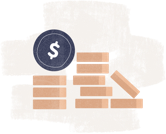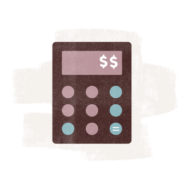Small Business Administration (SBA) loans are among the most popular and reliable ways for small businesses to secure funding. As with any financial product, however, loan rates change. What are the rates for business owners looking to get financing? It depends on the specific SBA loan.
Current SBA Loan Interest Rates 2020
- SBA CARES Paycheck Protection Program loan rate: 1%
- Economic Injury Disaster loan rate: 3.75% (2.75% for non-profits)
- SBA 504 current rates: 2.80% to 2.85%
- SBA 7(a) current rates: 5.5% to 8%
- SBA Microloan current rates: 7.75 to 8.5%
These are based on the April 1, 2020 prime rate of 3.25%.
Remember, prime rate changes all the time, and while the SBA sets maximum interest rates for most loans, even those can range by a few percentage points. Someone with excellent credit and borrowing a large amount of money may pay a full 2-3 points less than someone borrowing less and with only average credit scores. There is also a discount for loans that take longer to pay off. Those with terms of less than seven years can offer a lower rate.
Here’s a bit more detail about how much each loan product costs and the terms of each loan under the SBA program.
SBA Loan Terms
In addition to the rates for each type of loan, there are additional terms to consider. These can be just as important to an applicant as the rate, since the fees, interest, and accepted uses can determine if an SBA loan is indeed the best funding option. Here is a bit more about each loan and what is required, along with how long you have to pay it back and what the program may cost you.
SBA 504 Loans (CDC Loans)
If you qualify for an SBA 504 loan, you can expect to fit the SBA guidelines for a for-profit small business, depending on your industry. You can’t be considered eligible for regular funding through the participating bank, and you can’t use the money to pay off unsecured debt – such as a credit card. In fact, the 504 loan can only be used to pay for real estate, property, and long-term equipment costs. It cannot be used to help non-profit organizations.
Additional Reading: Does it Make Sense to Fund My Business With Home Equity?
Business loan amounts range from $125,000 to around $5 million. (The exact amount is up to the SBA and the lender.) The funds are designed to allow small business owners to invest in property that can be held for the life of their business. This is the ideal long-term financing program.
The term of the loan is either 10 or 20 years, and it works a bit differently than the 7(a) loan. There are essentially two separate portions, each financed by a different entity (and administered by a single lender.) One half of the loan comes from the bank, but the other amount (up to 40%) comes from a Certified Development Company (CDC) – which then sells your debt (also known as a debenture) to a private investor.
What about the other 10%? That comes from you – as a down payment. It works the same as for buying a house.
The rates are decided by the SBA and the bank, as the CDC-financed amount has a fixed rate, while the bank portion can charge their own rate. These are usually very low, however, as real estate loans tend to be. They can even be cheaper than current home financing options! Rates for a 20-year loan will average 2.80%; rates for the shorter, 10-year small business loans will be slightly higher at around 2.85%. The range will only slightly affect payments for most borrowers.
SBA 7(a) Loans
Of all the loans that small businesses seek, the SBA 7(a) loans are probably the best known. These loans have no minimum and range up to $5 million in funding for qualified businesses, but the lenders aren’t likely to issue business loans for less than $30,000. Borrowers have up to 25 years to pay off funds used for real estate and some other applications. For businesses who use the funding for equipment, working capital, or inventory, you have to pay back the money within ten years.
Since the SBA loans are given to businesses that may not traditionally get funding, the SBA offers to guarantee a certain amount of each business loan. For the SBA 7(a) loans, that number is approximately 75 – 85% of the loan amount. Larger loans have less guaranteed than smaller loans, meaning the bank will be on the hook for that additional amount should you default.
Specific rates for the SBA 7(a) loans are broken down by loan amount and loan term. At the time of this writing, the current prime rate is 3.25%, making the following variable rates.
SBA 7(a) Loan Rates
| Loan Amount | Loan Term of <7 years | Loan Term of >7 years |
| Under $25,001 | 7.5% (Prime + 4.25%) | 8% (Prime + 4.75%) |
| $25,001 – $50,000 | 6.5% (Prime + 3.25%) | 7% (Prime + 3.75%) |
| More than $50,000 | 5.5% (Prime + 2.25%) | 6% (Prime + 2.75%) |
Note that, in these examples, we used “Prime” set by the Fed for the base rate. Lenders, however, are free to use one of three standards for their base: Prime rate, LIBOR + 3.0%, or the SBA peg rate. Each of these is very close, differing by less than a portion of a percentage point. If you have a variable rate loan, you could see your costs fluctuate over time. Lenders can choose to offer fixed-rate financing or variable SBA loans at their discretion and may choose to charge prepayment penalty fees for early repayment. Short-term loans will cost less than long-term loans.
There are also fixed rate loans. These are:
| Loan Amount | Rate | Prime rate in effect on the first business day, plus: |
| Under $25,001 | 11.25% | 6.0% (600 basis points) plus the 2.0% (200 basis points) |
| $25,001 – $50,000 | 10.25% | 6.0% (600 basis points) plus the 1.0% (100 basis points) |
| $50,001 – $250,000 | 9.25% | 6.0% (600 basis points) |
| $250,001 or more | 8.25% | 5.0% (500 basis points) |
Read the terms of your loan carefully to know just what your monthly payments will be to the lender for the life of a loan. (SBA loan rates are just a portion of the total cost.)
SBA Microloans
Are you considering the smaller, but more easily-accessible SBA microloans? When repaying the SBA loan, you need to know that the rates can vary from bank to bank. Still, the SBA puts limits in place for lenders when charging interest to borrowers. The current maximum interest rate is:
- 7.75% for loans of more than $10,000
- 8.50% for loans of $10,000 or less
Loans will never be longer than six-year terms, and there is no such thing as a revolving line of credit used as a microloan. Not all of the microloans will require collateral, making them an attractive option for small businesses who need smaller funding sources.
What are SBA microloans used for?
These loans have some limitations. According to the SBA business lending requirements, the microloan program may be used for the purchase of “furniture, fixtures, supplies, materials, equipment, and/or for working capital.” The SBA prohibits it being used to buy real estate or for the home of a business owner, unless that home is used specifically for business. Lenders may choose to allow microloans to be used to refinance debt at their discretion – and only when they think it will improve cash flow for the business. Borrowers can use microloan funds to pay delinquent taxes in certain circumstances.
More about SBA Loan Fees
In addition to the loan rates and maximum allowable interest rates, most SBA loans have a guarantee fee. These are determined by the amount you borrow and apply to the guaranteed portion of the 7(a) loans, specifically. Guarantee fees range from 0% for certain veteran-owned business loans to 3.75% of the guaranteed portion of the loan. Origination fees are another cost, although some of these extras can be waived for veterans and those who qualify due to disasters.
{
“@context”: “https://schema.org”,
“@type”: “FAQPage”,
“mainEntity”: [{
“@type”: “Question”,
“name”: “How are SBA 504 Loan Rates determined?”,
“acceptedAnswer”: {
“@type”: “Answer”,
“text”: “As explained before, the CDC loan financiers have to follow SBA guidelines, but the lenders can choose their own loan rates under the limits. Since the program is designed to help businesses invest large amounts of money in real estate or equipment, however, the rates are made low to be competitive. While they do fluctuate with market forces, they can often be lower than the home loans you see on the market today.
The rate includes the Treasury bond rate, the guarantee fee (or guaranty fee) to the SBA, the servicing fee to the CDC, and a one-time fee of 2.15% to the SBA.”
}
}, {
“@type”: “Question”,
“name”: “How Can I Qualify for an SBA Loan?”,
“acceptedAnswer”: {
“@type”: “Answer”,
“text”: “Because preferred lenders participate in the SBA program, and each bank is responsible for issuing and collecting on the loan, they can have slightly different SBA loan requirements. They’ll commonly ask that a business meet these standards, however:
- You must have invested some of your own money into the business, even if it’s a startup.
- You must have tried to get funding through traditional sources or have been unable to meet the requirements for applying for other funds. (The SBA likes to be your last effort.)
- You must have proof that you can maintain the cost of your business and that you can repay the loan. This comes with sales reports, credit card sales, invoices, etc. The bank needs to know you are worth the credit risk and can sustain payments.
- You must have good personal and business credit scores. If you don’t have well-established business credit, excellent personal credit and good sales numbers might qualify you.
Because credit is such a major factor in deciding to approve you for an SBA loan, it pays to know your personal and business credit scores. Get these ahead of filling out your loan application, so that you don’t have any surprises when it’s time to meet with lenders. Banks must use this information to determine your ability to repay, and they can turn you down without it.”
}
}, {
“@type”: “Question”,
“name”: “Is there a formal SBA loan rates calculator I can use?”,
“acceptedAnswer”: {
“@type”: “Answer”,
“text”: “You don’t really need a calculator for most SBA loans, as they are transparent about their fees. Each lender may set their own rates and additional fees allowed under the program terms. To know exactly what a loan will cost you, see the terms of the lender program you apply to directly and ask what your monthly payments will be. Some online lenders that you may find through the SBA program could have more tools, as well.”
}
}, {
“@type”: “Question”,
“name”: “How the SBA loans 2019 differ from previous years?”,
“acceptedAnswer”: {
“@type”: “Answer”,
“text”: “Rates change often, but the SBA tries to set their rates at a standard that doesn’t fluctuate often. While prime (the rate set by the Federal Reserve) can change many times a year, portions of the business loan programs don’t change as often. Each year may see increases, as the government responds to market influences. 2019 saw higher rates than 2018, for example, due to the Fed raising rates in 2018. The lenders have to keep up with rates, so things may be different by next year.”
}
}]
}
Frequently Asked Questions
How are SBA 504 Loan Rates determined?
As explained before, the CDC loan financiers have to follow SBA guidelines, but the lenders can choose their own loan rates under the limits. Since the program is designed to help businesses invest large amounts of money in real estate or equipment, however, the rates are made low to be competitive. While they do fluctuate with market forces, they can often be lower than the home loans you see on the market today.
The rate includes the Treasury bond rate, the guarantee fee (or guaranty fee) to the SBA, the servicing fee to the CDC, and a one-time fee of 2.15% to the SBA.
How Can I Qualify for an SBA Loan?
Because preferred lenders participate in the SBA program, and each bank is responsible for issuing and collecting on the loan, they can have slightly different SBA loan requirements. They’ll commonly ask that a business meet these standards, however:
- You must have invested some of your own money into the business, even if it’s a startup.
- You must have tried to get funding through traditional sources or have been unable to meet the requirements for applying for other funds. (The SBA likes to be your last effort.)
- You must have proof that you can maintain the cost of your business and that you can repay the loan. This comes with sales reports, credit card sales, invoices, etc. The bank needs to know you are worth the credit risk and can sustain payments.
- You must have good personal and business credit scores. If you don’t have well-established business credit, excellent personal credit and good sales numbers might qualify you.
Because credit is such a major factor in deciding to approve you for an SBA loan, it pays to know your personal and business credit scores. Get these ahead of filling out your loan application, so that you don’t have any surprises when it’s time to meet with lenders. Banks must use this information to determine your ability to repay, and they can turn you down without it.
Is there a formal SBA loan rates calculator I can use?
There is! Nav Inc. created the first calculator for the new Paycheck Protection Program. You don’t really need a calculator for other SBA loans, as they are transparent about their fees. Each lender may set their own rates and additional fees allowed under the program terms. To know exactly what a loan will cost you, see the terms of the lender program you apply to directly and ask what your monthly payments will be. Some online lenders that you may find through the SBA program could have more tools, as well.
How the SBA loans 2020 differ from previous years?
Rates change often, but the SBA tries to set their rates at a standard that doesn’t fluctuate often. While prime (the rate set by the Federal Reserve) can change many times a year, portions of the business loan programs don’t change as often. Each year may see increases, as the government responds to market influences. 2019 saw higher rates than 2018, for example, due to the Fed raising rates in 2018. Rates were then lowered due to the COVID-19 crisis. The lenders have to keep up with rates, so things may be different by next year.
Related Resources:
- COVID Disaster Loans Vs. Paycheck Protection Loans
- Avoid Small Business Lending Scams and Fraud Related to COVID-19
- What is the Economic Injury Disaster Loan Grant and What Does It Mean for Small Business?
- COVID-19 Resources and Guidance By State
- Frequently Asked Questions About CARES Act Paycheck Protection Loans for Small Business
- Frequently Asked Questions About Applying for SBA Disaster Loans Due to Coronavirus
- Prepare Your Application for the SBA Paycheck Protection Program
This article was originally written on June 21, 2019 and updated on April 4, 2020.




Have at it! We'd love to hear from you and encourage a lively discussion among our users. Please help us keep our site clean and protect yourself. Refrain from posting overtly promotional content, and avoid disclosing personal information such as bank account or phone numbers.
Reviews Disclosure: The responses below are not provided or commissioned by the credit card, financing and service companies that appear on this site. Responses have not been reviewed, approved or otherwise endorsed by the credit card, financing and service companies and it is not their responsibility to ensure all posts and/or questions are answered.